A Review of Current Challenges and Case Study toward Optimizing Micro-Computed X-Ray Tomography of Carbon Fabric Composites
Abstract
:1. Introduction
1.1. General Challenges in 3D Imaging of Advanced Composites
1.2. State of the Art in Micro-CT of Woven Fabric Composites
2. Case Study
2.1. Materials
2.2. Micro-CT Acquisition
2.2.1. Principles
2.2.2. Optimizing Sample Mounting, Scan Parameters and Filter Selection
2.2.3. Contrast Enhancement
2.2.4. Scanning
3. Results and Discussion
3.1. Visualization
3.2. Post-Processing and Analysis
3.2.1. Filtering and Segmentation
3.2.2. Geometry Extraction and Meshing
3.2.3. Simulation
4. Conclusions and Future Prospect
Author Contributions
Funding
Acknowledgments
Conflicts of Interest
Appendix A. Understanding the Effect of Filtering and the Necessity for Trial and Errors


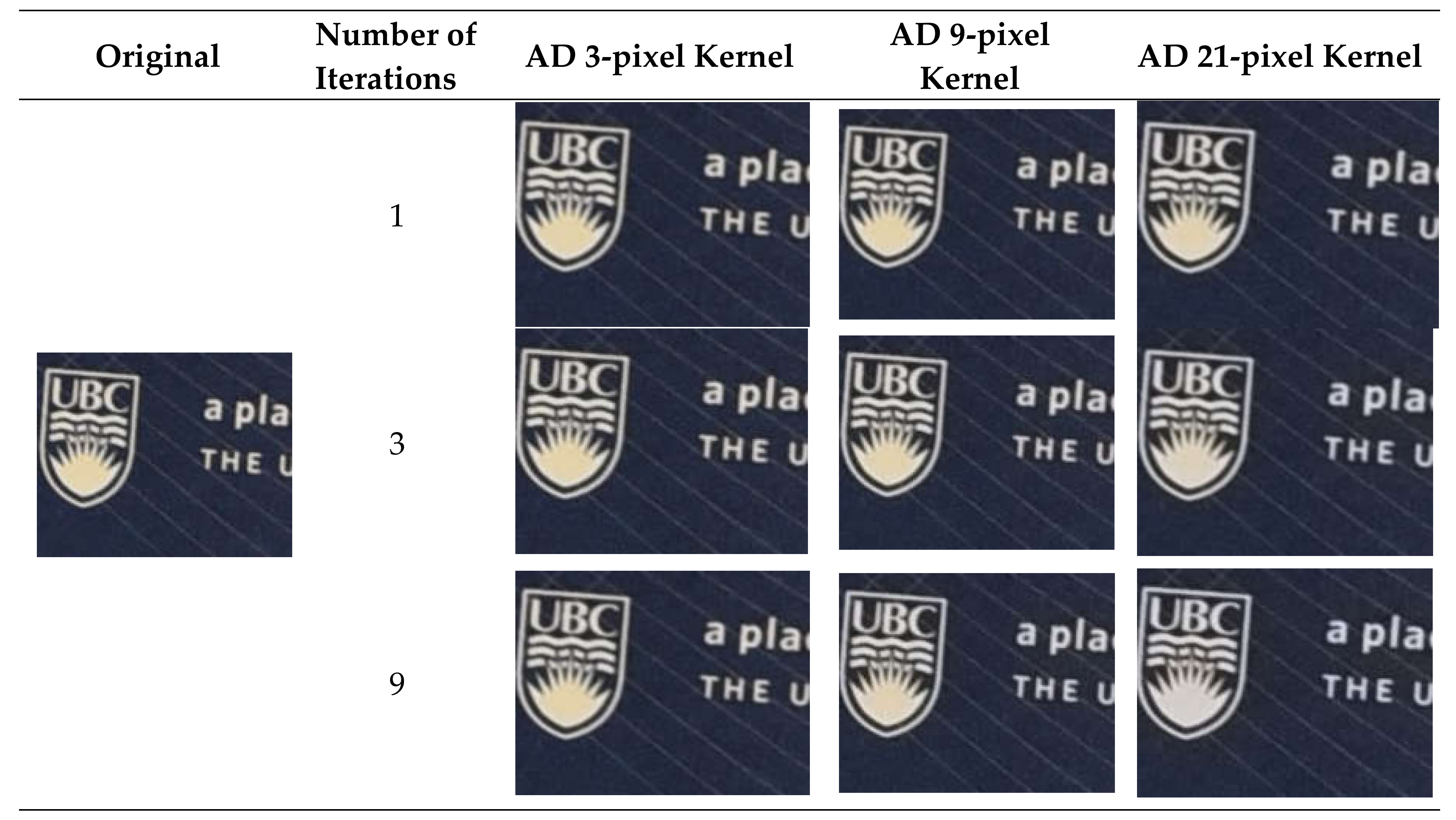
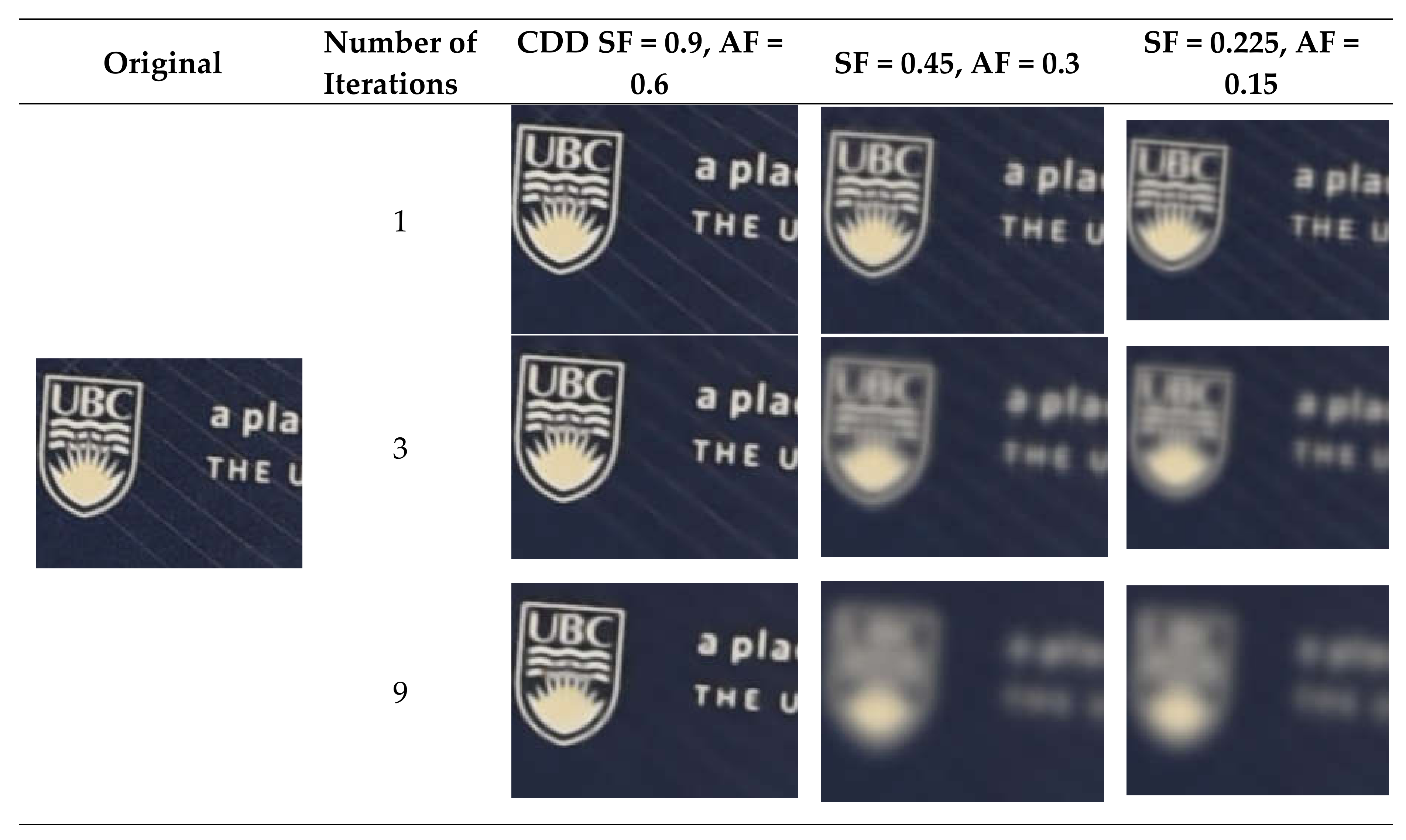

References
- Garcea, S.; Wang, Y.; Withers, P. X-ray computed tomography of polymer composites. Compos. Sci. Technol. 2018, 156, 305–319. [Google Scholar] [CrossRef]
- Rique, A.M.; Machado, A.C.; Oliveira, D.; Lopes, R.; Lima, I. X-ray imaging inspection of fiberglass reinforced by epoxy composite. Nucl. Instrum. Methods Phys. Res. Sect. B Beam Interact. Mater. At. 2015, 349, 184–191. [Google Scholar] [CrossRef]
- Quan, Z.; Larimore, Z.; Qin, X.; Yu, J.; Mirotznik, M.; Byun, J.-H.; Oh, Y.; Chou, T.-W. Microstructural characterization of additively manufactured multi-directional preforms and composites via X-ray micro-computed tomography. Compos. Sci. Technol. 2016, 131, 48–60. [Google Scholar] [CrossRef]
- Saunders, R.; Lekakou, C.; Bader, M. Compression and microstructure of fibre plain woven cloths in the processing of polymer composites. Compos. Part A Appl. Sci. Manuf. 1998, 29, 443–454. [Google Scholar] [CrossRef]
- Hu, X.; Wang, L.; Xu, F.; Xiao, T.; Zhang, Z. In situ observations of fractures in short carbon fiber/epoxy composites. Carbon 2014, 67, 368–376. [Google Scholar] [CrossRef]
- Kiziltaş, G.; Papila, M.; Yilmaz, B.; Bilge, K. Challenges in Micro-CT characterization of composites. In Micro-Computed Tomography (Micro-CT) in Medicine Engineering; Springer: Berlin, Germany, 2020; pp. 225–246. [Google Scholar]
- Gholizadeh, S. A review of non-destructive testing methods of composite materials. Procedia Struct. Integr. 2016, 1, 50–57. [Google Scholar] [CrossRef] [Green Version]
- Djukic, L.P.; Herszberg, I.; Walsh, W.R.; Schoeppner, G.A.; Prusty, B.G.; Kelly, D.W. Contrast enhancement in visualisation of woven composite tow architecture using a MicroCT Scanner. Part 1: Fabric coating and resin additives. Compos. Part A Appl. Sci. Manuf. 2009, 40, 553–565. [Google Scholar] [CrossRef]
- Stock, S. X-ray microtomography of materials. Int. Mater. Rev. 1999, 44, 141–164. [Google Scholar] [CrossRef]
- Aoyagi, Y.; Takahashi, H.; Iwasaki, N.; Honda, E.-I.; Kurabayashi, T. Radiopacity of experimental composite resins containing radiopaque materials. Dent. Mater. J. 2005, 24, 315–320. [Google Scholar] [CrossRef] [Green Version]
- Ting, J. Quantitative Evaluation of Material Composition of Composites Using X-Ray Energy-Dispersive NDE Technique. Master’s Thesis, Iowa State University, Ames, IA, USA, 1993. [Google Scholar]
- Krumenacker, N.; Madra, A.; Hubert, P. Image-based characterization of fibre waviness in a representative vacuum-bagged corner laminate. Compos. Part A Appl. Sci. Manuf. 2020, 131, 105774. [Google Scholar] [CrossRef]
- Schell, J.; Renggli, M.; Van Lenthe, G.; Müller, R.; Ermanni, P. Micro-computed tomography determination of glass fibre reinforced polymer meso-structure. Compos. Sci. Technol. 2006, 66, 2016–2022. [Google Scholar] [CrossRef]
- Schilling, P.J.; Karedla, B.R.; Tatiparthi, A.K.; Verges, M.A.; Herrington, P.D. X-ray computed microtomography of internal damage in fiber reinforced polymer matrix composites. Compos. Sci. Technol. 2005, 65, 2071–2078. [Google Scholar] [CrossRef]
- De Santis, R.; Mollica, F.; Prisco, D.; Rengo, S.; Ambrosio, L.; Nicolais, L. A 3D analysis of mechanically stressed dentin–adhesive–composite interfaces using X-ray micro-CT. Biomaterials 2005, 26, 257–270. [Google Scholar] [CrossRef]
- Zhang, H.; Yu, L.; Hassler, U.; Fernandes, H.; Genest, M.; Robitaille, F.; Joncas, S.; Holub, W.; Sheng, Y.; Maldague, X. An experimental and analytical study of micro-laser line thermography on micro-sized flaws in stitched carbon fiber reinforced polymer composites. Compos. Sci. Technol. 2016, 126, 17–26. [Google Scholar] [CrossRef] [Green Version]
- Straumit, I.; Hahn, C.; Winterstein, E.; Plank, B.; Lomov, S.V.; Wevers, M. Computation of permeability of a non-crimp carbon textile reinforcement based on X-ray computed tomography images. Compos. Part A Appl. Sci. Manuf. 2016, 81, 289–295. [Google Scholar] [CrossRef]
- Centea, T.; Hubert, P. Measuring the impregnation of an out-of-autoclave prepreg by micro-CT. Compos. Sci. Technol. 2011, 71, 593–599. [Google Scholar] [CrossRef]
- Pazmino, J.; Carvelli, V.; Lomov, S.V. Micro-CT analysis of the internal deformed geometry of a non-crimp 3D orthogonal weave E-glass composite reinforcement. Compos. Part B Eng. 2014, 65, 147–157. [Google Scholar] [CrossRef]
- Wang, W.; Kravchenko, A.; Smucker, A.; Rivers, M. Comparison of image segmentation methods in simulated 2D and 3D microtomographic images of soil aggregates. Geoderma 2011, 162, 231–241. [Google Scholar] [CrossRef]
- Kronman, A.; Joskowicz, L. Image segmentation errors correction by mesh segmentation and deformation. In Proceedings of the International Conference on Medical Image Computing and Computer-Assisted Intervention, Nagoya, Japan, 22–26 September 2013; pp. 206–213. [Google Scholar]
- Shi, R.; Ngan, K.N.; Li, S. The objective evaluation of image object segmentation quality. In Proceedings of the International Conference on Advanced Concepts for Intelligent Vision Systems, Poznań, Poland, 28–31 October 2013; pp. 470–479. [Google Scholar]
- Taha, A.A.; Hanbury, A. Metrics for evaluating 3D medical image segmentation: Analysis, selection, and tool. BMC Med Imaging 2015, 15, 29. [Google Scholar] [CrossRef] [Green Version]
- Kastner, J.; Plank, B.; Salaberger, D.; Sekelja, J. Defect and porosity determination of fibre reinforced polymers by X-ray computed tomography. In Proceedings of the 2nd International Symposium on NDT in Aerospace, Hamburg, Germany, 22–24 November 2010; pp. 1–12. [Google Scholar]
- Emerson, M.J.; Jespersen, K.M.; Dahl, A.B.; Conradsen, K.; Mikkelsen, L.P. Individual fibre segmentation from 3D X-ray computed tomography for characterising the fibre orientation in unidirectional composite materials. Compos. Part A Appl. Sci. Manuf. 2017, 97, 83–92. [Google Scholar] [CrossRef]
- Jerjen, I.; Revol, V.; Schuetz, P.; Kottler, C.; Kaufmann, R.; Luethi, T.; Jefimovs, K.; Urban, C.; Sennhauser, U. Reduction of phase artifacts in differential phase contrast computed tomography. Opt. Express 2011, 19, 13604–13611. [Google Scholar] [CrossRef] [PubMed]
- Iassonov, P.; Gebrenegus, T.; Tuller, M. Segmentation of X-ray computed tomography images of porous materials: A crucial step for characterization and quantitative analysis of pore structures. Water Resour. Res. 2009, 45, 1–12. [Google Scholar] [CrossRef]
- Aroush, D.R.-B.; Maire, E.; Gauthier, C.; Youssef, S.; Cloetens, P.; Wagner, H. A study of fracture of unidirectional composites using in situ high-resolution synchrotron X-ray microtomography. Compos. Sci. Technol. 2006, 66, 1348–1353. [Google Scholar] [CrossRef]
- McCombe, G.; Rouse, J.; Trask, R.; Withers, P.; Bond, I. X-ray damage characterisation in self-healing fibre reinforced polymers. Compos. Part A Appl. Sci. Manuf. 2012, 43, 613–620. [Google Scholar] [CrossRef]
- Melenka, G.W.; Lepp, E.; Cheung, B.K.; Carey, J.P. Micro-computed tomography analysis of tubular braided composites. Compos. Struct. 2015, 131, 384–396. [Google Scholar] [CrossRef]
- Zuva, T.; Olugbara, O.O.; Ojo, S.O.; Ngwira, S.M. Image segmentation, available techniques, developments and open issues. Can. J. Image Process. Comput. Vis. 2011, 2, 20–29. [Google Scholar]
- Gauch, J.M. Image segmentation and analysis via multiscale gradient watershed hierarchies. IEEE Trans. Image Process. 1999, 8, 69–79. [Google Scholar] [CrossRef] [Green Version]
- Kaur, J.; Agrawal, S.; Vig, R. A comparative analysis of thresholding and edge detection segmentation techniques. Int. J. Comput. Appl. 2012, 39, 29–34. [Google Scholar] [CrossRef]
- Al-Amri, S.S.; Kalyankar, N.; Khamitkar, S. Image segmentation by using edge detection. Int. J. Comput. Sci. Eng. 2010, 2, 804–807. [Google Scholar]
- Acharjya, P.P.; Das, R.; Ghoshal, D. Study and comparison of different edge detectors for image segmentation. Glob. J. Comput. Sci. Technol. 2012, 7, 29–32. [Google Scholar]
- Spyridonos, P.; Glotsos, D.; Cavouras, D.; Ravazoula, P.; Zolota, V.; Nikiforidis, G. Pattern recognition based segmentation method of cell nuclei in tissue section analysis. In Proceedings of the14th International Conference on Digital Signal Processing (Cat. No. 02TH8628), Santorini, Greece, 1–3 July 2002; pp. 1121–1124. [Google Scholar]
- Muneeswaran, K.; Ganesan, L.; Arumugam, S.; Soundar, K.R. Texture image segmentation using combined features from spatial and spectral distribution. Pattern Recognit. Lett. 2006, 27, 755–764. [Google Scholar] [CrossRef]
- Zankowski, C. Knowledge-Based Automatic Image Segmentation. U.S. Patent 9,454,823, 27 September 2016. [Google Scholar]
- Sakai, T.; Wakayama, S.; Pérez-Pacheco, E.; Rodriguez-Laviada, J.; Rios-Soberanis, C. Damage accumulation behavior of non-crimp fabric-reinforced epoxy composite under static and cyclic tensile loading. Adv. Compos. Mater. 2013, 22, 281–297. [Google Scholar] [CrossRef]
- Geller, S.; Weissenborn, O.; Gude, M.; Czulak, A. Impregnation studies and mechanical characterization of cellular, natural, fiber-reinforced, composite structures. Polimery 2016, 61, 125–132. [Google Scholar] [CrossRef]
- Desplentere, F.; Lomov, S.V.; Woerdeman, D.; Verpoest, I.; Wevers, M.; Bogdanovich, A. Micro-CT characterization of variability in 3D textile architecture. Compos. Sci. Technol. 2005, 65, 1920–1930. [Google Scholar] [CrossRef]
- Rashidi, A.; Milani, A. Characterization of wrinkling and de-wrinkling behaviour of woven fabrics using a multi-step biaxial bias extension test. In Proceedings of the ECCM17-17th European Conference on Composite Materials, Munich, Germany, 26–30 June 2016; pp. 26–30. [Google Scholar]
- Remeysen, K.; Swennen, R. Beam hardening artifact reduction in microfocus computed tomography for improved quantitative coal characterization. Int. J. Coal Geol. 2006, 67, 101–111. [Google Scholar] [CrossRef]
- Aravand, M.A.; Shishkina, O.; Straumit, I.; Liotta, A.H.; Wicks, S.S.; Wardle, B.L.; Lomov, S.V.; Gorbatikh, L. Internal geometry of woven composite laminates with “fuzzy” carbon nanotube grafted fibers. Compos. Part A Appl. Sci. Manuf. 2016, 88, 295–304. [Google Scholar] [CrossRef]
- Wan, Y.; Straumit, I.; Takahashi, J.; Lomov, S.V. Micro-CT analysis of internal geometry of chopped carbon fiber tapes reinforced thermoplastics. Compos. Part A Appl. Sci. Manuf. 2016, 91, 211–221. [Google Scholar] [CrossRef]
- Shen, H.; Nutt, S.; Hull, D. Direct observation and measurement of fiber architecture in short fiber-polymer composite foam through micro-CT imaging. Compos. Sci. Technol. 2004, 64, 2113–2120. [Google Scholar] [CrossRef]
- Mehdikhani, M.; Gorbatikh, L.; Verpoest, I.; Lomov, S.V. Voids in fiber-reinforced polymer composites: A review on their formation, characteristics, and effects on mechanical performance. J. Compos. Mater. 2019, 53, 1579–1669. [Google Scholar] [CrossRef]
- Nikishkov, Y.; Airoldi, L.; Makeev, A. Measurement of voids in composites by X-ray Computed Tomography. Compos. Sci. Technol. 2013, 89, 89–97. [Google Scholar] [CrossRef]
- Sisodia, S.M.; Garcea, S.; George, A.; Fullwood, D.; Spearing, S.; Gamstedt, E. High-resolution computed tomography in resin infused woven carbon fibre composites with voids. Compos. Sci. Technol. 2016, 131, 12–21. [Google Scholar] [CrossRef] [Green Version]
- Feng, Y.; Feng, Z.; Li, S.; Zhang, W.; Luan, X.; Liu, Y.; Cheng, L.; Zhang, L. Micro-CT characterization on porosity structure of 3D Cf/SiCm composite. Compos. Part A Appl. Sci. Manuf. 2011, 42, 1645–1650. [Google Scholar] [CrossRef]
- Bull, D.; Sinclair, I.; Spearing, S. Partial volume correction for approximating crack opening displacements in CFRP material obtained from micro-focus X-ray CT scans. Compos. Sci. Technol. 2013, 81, 9–16. [Google Scholar] [CrossRef] [Green Version]
- Cosmi, F.; Bernasconi, A. Micro-CT investigation on fatigue damage evolution in short fibre reinforced polymers. Compos. Sci. Technol. 2013, 79, 70–76. [Google Scholar] [CrossRef]
- Jespersen, K.M.; Zangenberg, J.; Lowe, T.; Withers, P.J.; Mikkelsen, L.P. Fatigue damage assessment of uni-directional non-crimp fabric reinforced polyester composite using X-ray computed tomography. Compos. Sci. Technol. 2016, 136, 94–103. [Google Scholar] [CrossRef] [Green Version]
- Awaja, F.; Nguyen, M.-T.; Zhang, S.; Arhatari, B. The investigation of inner structural damage of UV and heat degraded polymer composites using X-ray micro CT. Compos. Part A Appl. Sci. Manuf. 2011, 42, 408–418. [Google Scholar] [CrossRef]
- Baran, I.; Straumit, I.; Shishkina, O.; Lomov, S.V. X-ray computed tomography characterization of manufacturing induced defects in a glass/polyester pultruded profile. Compos. Struct. 2018, 195, 74–82. [Google Scholar] [CrossRef]
- Abdin, Y.; Lomov, S.V.; Jain, A.; Van Lenthe, G.; Verpoest, I. Geometrical characterization and micro-structural modeling of short steel fiber composites. Compos. Part A Appl. Sci. Manuf. 2014, 67, 171–180. [Google Scholar] [CrossRef]
- Nguyen, M.; Herszberg, I.; Paton, R. The shear properties of woven carbon fabric. Compos. Struct. 1999, 47, 767–779. [Google Scholar] [CrossRef]
- Harjkova, G.; Barburski, M.; Lomov, S.V.; Kononova, O.; Verpoest, I. Weft knitted loop geometry of glass and steel fiber fabrics measured with X-ray micro-computer tomography. Text. Res. J. 2014, 84, 500–512. [Google Scholar] [CrossRef]
- Rashidi, A.; Milani, A. A multi-step biaxial bias extension test for wrinkling/de-wrinkling characterization of woven fabrics: Towards optimum forming design guidelines. Mater. Des. 2018, 146, 273–285. [Google Scholar] [CrossRef]
- Naouar, N.; Vidal-Sallé, E.; Schneider, J.; Maire, E.; Boisse, P. Meso-scale FE analyses of textile composite reinforcement deformation based on X-ray computed tomography. Compos. Struct. 2014, 116, 165–176. [Google Scholar] [CrossRef]
- Badel, P.; Vidal-Sallé, E.; Maire, E.; Boisse, P. Simulation and tomography analysis of textile composite reinforcement deformation at the mesoscopic scale. Compos. Sci. Technol. 2008, 68, 2433–2440. [Google Scholar] [CrossRef] [Green Version]
- Stock, S.R. Microcomputed Tomography: Methodology Applications; CRC Press: Boca Raton, FL, USA, 2008. [Google Scholar]
- Cullity, B. Elements of X-Ray Diffraction. Am. J. Phys. 1957, 25, 394–395. [Google Scholar] [CrossRef] [Green Version]
- Grodzins, L. Optimum energies for x-ray transmission tomography of small samples: Applications of synchrotron radiation to computerized tomography I. Nucl. Instrum. Methods Phys. Res. 1983, 206, 541–545. [Google Scholar] [CrossRef]
- Beister, M.; Kolditz, D.; Kalender, W.A. Iterative reconstruction methods in X-ray CT. Phys. Med. 2012, 28, 94–108. [Google Scholar] [CrossRef]
- Gilbert, P. Iterative methods for the three-dimensional reconstruction of an object from projections. J. Theor. Biol. 1972, 36, 105–117. [Google Scholar] [CrossRef]
- Du Plessis, A.; Broeckhoven, C.; Guelpa, A.; Le Roux, S.G. Laboratory X-ray micro-computed tomography: A user guideline for biological samples. GigaScience 2017, 6, gix027. [Google Scholar] [CrossRef]
- Li, H.; Zhang, H.; Tang, Z.; Hu, G. Micro-computed tomography for small animal imaging: Technological details. Prog. Nat. Sci. 2008, 18, 513–521. [Google Scholar] [CrossRef]
- Westendorf, J.J. Osteoporosis. Methods Mol. Biol. (Clifton, NJ) 2008, 455. [Google Scholar]
- Kastner, J.; Plank, B.; Kottler, C.; Revol, V. Comparison of phase contrast X-ray computed tomography methods for non-destructive testing of materials. In Proceedings of the 12th World Conference on Non-Destructive Testing, Amsterdam, The Netherlands, 23–28 April 1989; p. 12. [Google Scholar]
- Momose, A.; Takeda, T.; Itai, Y.; Hirano, K. Phase–contrast X–ray computed tomography for observing biological soft tissues. Nat. Med. 1996, 2, 473–475. [Google Scholar] [CrossRef] [PubMed]
- Gulsoy, E.B.; Shahani, A.J.; Gibbs, J.W.; Fife, J.L.; Voorhees, P.W. Four-dimensional morphological evolution of an aluminum silicon alloy using propagation-based phase contrast X-ray tomographic microscopy. Mater. Trans. 2014, 55, 161–164. [Google Scholar] [CrossRef] [Green Version]
- Contrast with Submicron 3D X-ray Imaging; Carl Zeiss Microscopy GmbH: Pleasanton, CA, USA, 2014.
- Stock, S. Recent advances in X-ray microtomography applied to materials. Int. Mater. Rev. 2008, 53, 129–181. [Google Scholar] [CrossRef]
- Feldkamp, L.; Davis, L.; Kress, J. Practical cone-beam algorithm. J. Opt. Soc. Am. 1984, 1, 612–619. [Google Scholar] [CrossRef] [Green Version]
- Thermo Fisher Scientific. Thermo Scientific Avizo Software 9, User’s Guide; 2018. Available online: https://assets.thermofisher.com/TFS-Assets/MSD/Product-Guides/user-guide-avizo-software.pdf (accessed on 14 August 2020).
- Bradley, R.S.; McNeil, A.; Withers, P.J. An examination of phase retrieval algorithms as applied to phase contrast tomography using laboratory sources. In Proceedings of the Developments in X-Ray Tomography Vii, Bellingham, WA, USA, 2–5 August 2010; p. 780404. [Google Scholar]
- Henke, B.L.; Gullikson, E.M.; Davis, J.C. X-ray Interactions: Photoabsorption, Scattering, Transmission and Reflection E = 50 − 30,000 eV, Z = 1 − 92. At. Data Nucl. Data Tables 1993, 54, 181–342. [Google Scholar] [CrossRef] [Green Version]
- Boas, F.; Fleischmann, D. Ct artifacts: Causes reduction techniques. Imaging Med. 2012, 4, 229–240. [Google Scholar] [CrossRef] [Green Version]
- Stolojescu-CriŞan, C.; Holban, Ş. A comparison of X-ray image segmentation techniques. Adv. Electr. Comput. Eng. 2013, 13, 85–92. [Google Scholar] [CrossRef]
- Zhu, L.; Wang, X.; Hinestroza, J.P.; Naebe, M. Determination of the porosity in a bifacial fabric using micro-computed tomography and three-dimensional reconstruction. Text. Res. J. 2018, 88, 1263–1277. [Google Scholar] [CrossRef]
- Straumit, I.; Lomov, S.V.; Wevers, M. Quantification of micro-CT images of textile reinforcements. In AIP Conference Proceedings; AIP Publishing LLC: Melville, NY, USA, 2017; Volume 1896, p. 030013. [Google Scholar]
- Naouar, N.; Vidal-Salle, E.; Schneider, J.; Maire, E.; Boisse, P. 3D composite reinforcement meso FE analyses based on X-ray computed tomography. Compos. Struct. 2015, 132, 1094–1104. [Google Scholar] [CrossRef]
- Yousaf, Z.; Potluri, P.; Withers, P.; Mollenhauer, D.; Zhou, E.; Duning, S. Digital element simulation of aligned tows during compaction validated by computed tomography (CT). Int. J. Solids Struct. 2018, 154, 78–87. [Google Scholar] [CrossRef] [Green Version]
- Vanaerschot, A.; Cox, B.N.; Lomov, S.V.; Vandepitte, D. Stochastic framework for quantifying the geometrical variability of laminated textile composites using micro-computed tomography. Compos. Part A Appl. Sci. Manuf. 2013, 44, 122–131. [Google Scholar] [CrossRef]
- Lorensen, W.E.; Cline, H.E. Marching cubes: A high resolution 3D surface construction algorithm. ACM Siggraph Comput. Graph. 1987, 21, 163–169. [Google Scholar] [CrossRef]
- Czabaj, M.W.; Riccio, M.L.; Whitacre, W.W. Numerical reconstruction of graphite/epoxy composite microstructure based on sub-micron resolution X-ray computed tomography. Compos. Sci. Technol. 2014, 105, 174–182. [Google Scholar] [CrossRef]
- Thompson, A.J.; El Said, B.; Ivanov, D.; Belnoue, J.P.; Hallett, S.R. High fidelity modelling of the compression behaviour of 2D woven fabrics. Int. J. Solids Struct. 2018, 154, 104–113. [Google Scholar] [CrossRef] [Green Version]
- Lin, H.; Zeng, X.; Sherburn, M.; Long, A.C.; Clifford, M.J. Automated geometric modelling of textile structures. Text. Res. J. 2012, 82, 1689–1702. [Google Scholar] [CrossRef]
- Kashani, M.H.; Rashidi, A.; Crawford, B.; Milani, A. Analysis of a two-way tension-shear coupling in woven fabrics under combined loading tests: Global to local transformation of non-orthogonal normalized forces and displacements. Compos. Part A Appl. Sci. Manuf. 2016, 88, 272–285. [Google Scholar] [CrossRef]
- Elliott, J.; Stock, S.; Anderson, P.; Davis, G. Quantitative Characterization of Damage in a Composite Material Using X-Ray Tomographic Microscopy. In Proceedings of the X-Ray Microscopy III, Proceedings of the Third International Conference; London, UK, 3–7 September 1990, p. 465.
- Ren, L.; Ghani, M.U.; Wu, D.; Zheng, B.; Chen, Y.; Yang, K.; Wu, X.; Liu, H. The impact of spectral filtration on image quality in micro-CT system. J. Appl. Clin. Med. Phys. 2016, 17, 301–315. [Google Scholar] [CrossRef] [Green Version]
- Fiore, L.; Corsini, G.; Geppetti, L. Application of non-linear filters based on the median filter to experimental and simulated multiunit neural recordings. J. Neurosci. Methods 1996, 70, 177–184. [Google Scholar] [CrossRef]
- Qiao, X. The principle curvature-driven diffusion model for image de-noising. In Proceedings of the 3rd International Conference on Multimedia Technology (ICMT-13); Atlantis Press: Paris, France, 2013. [Google Scholar]
- Hall, M. Smooth operator Smoothing seismic interpretations and attributes. Lead. Edge 2007, 26, 16–20. [Google Scholar] [CrossRef]
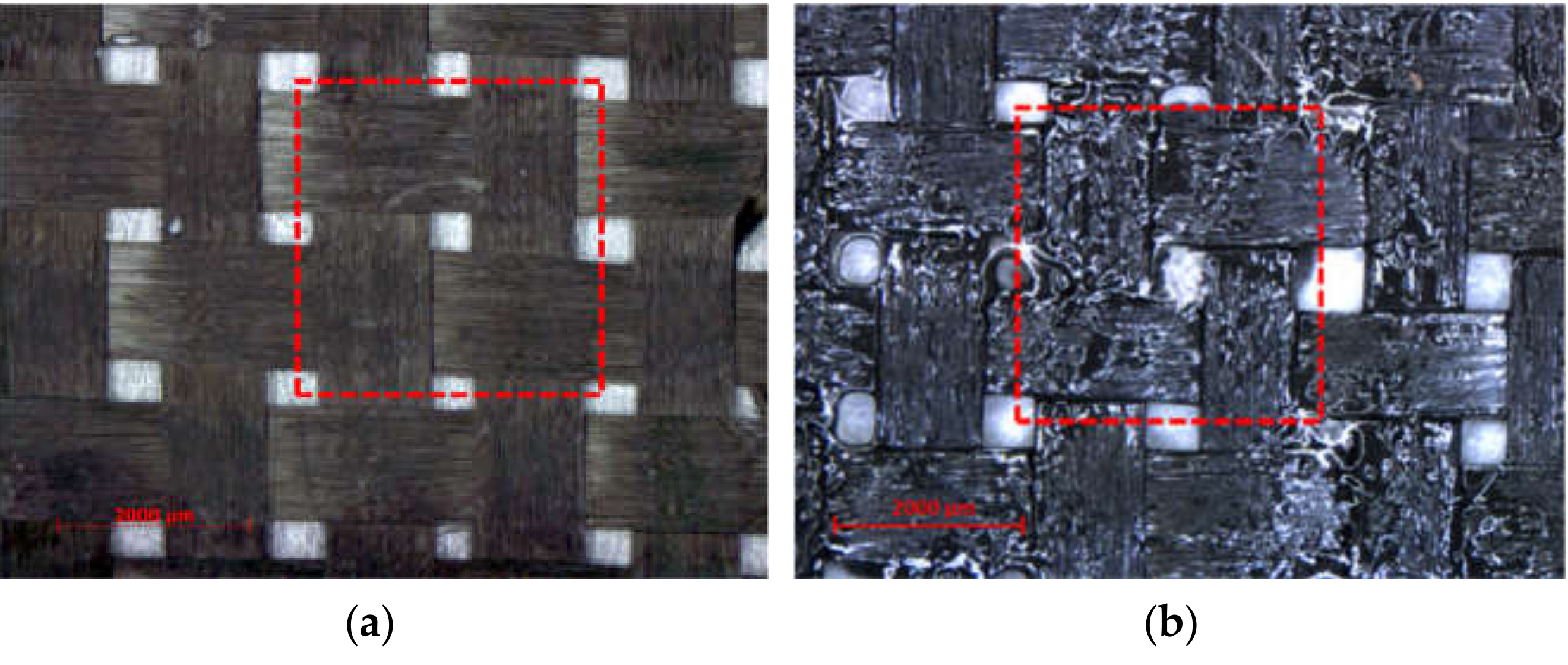
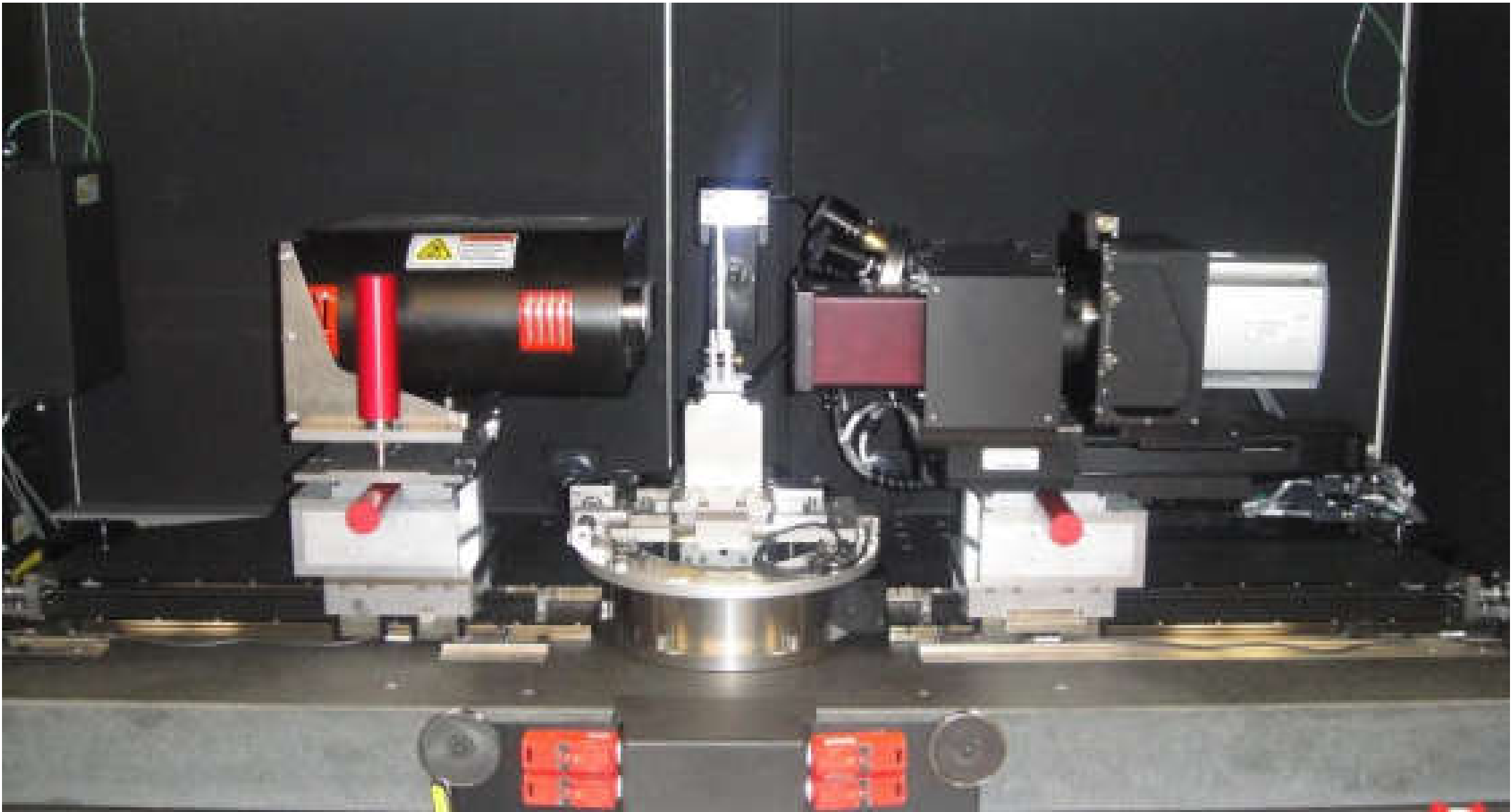
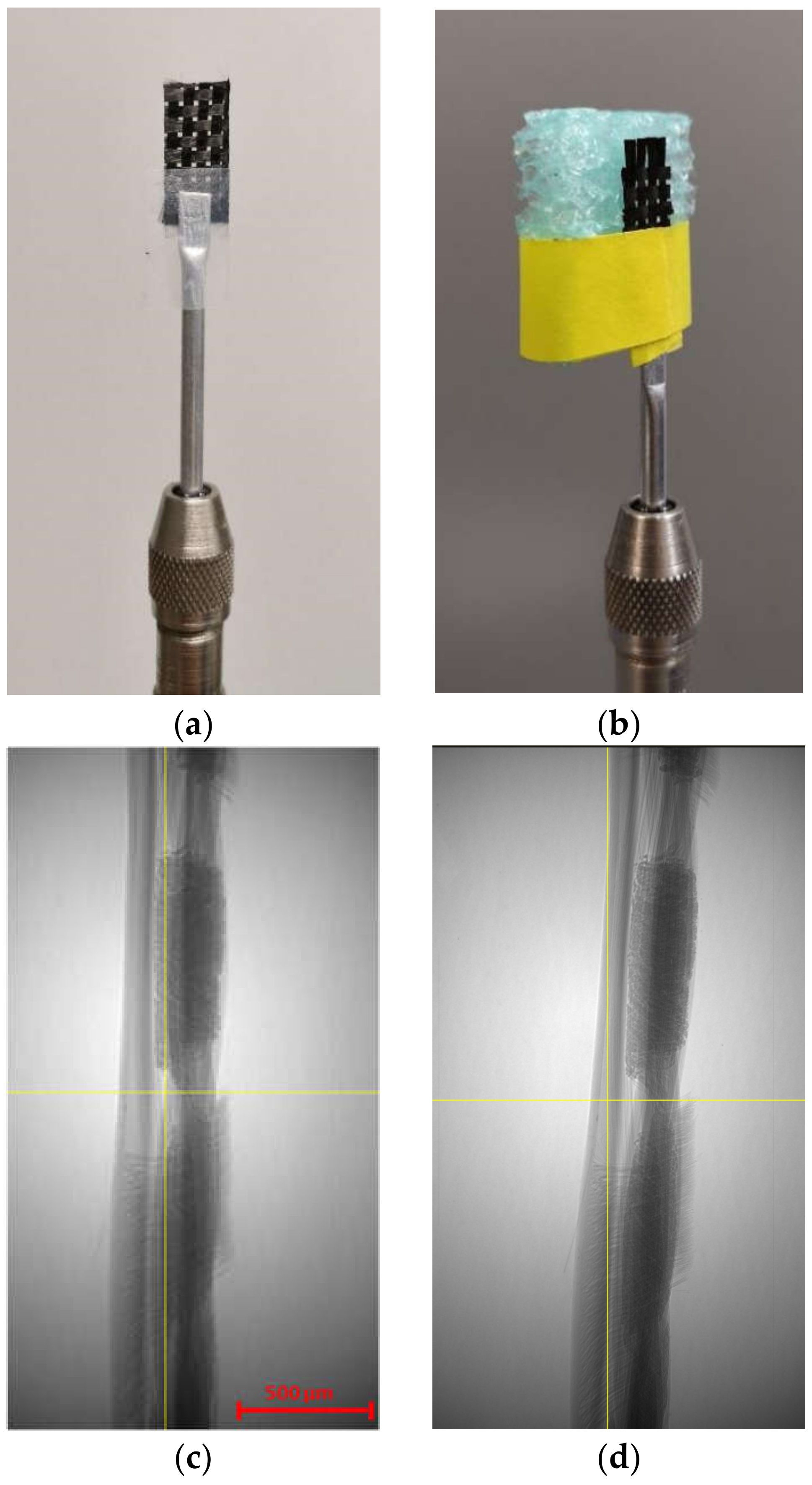
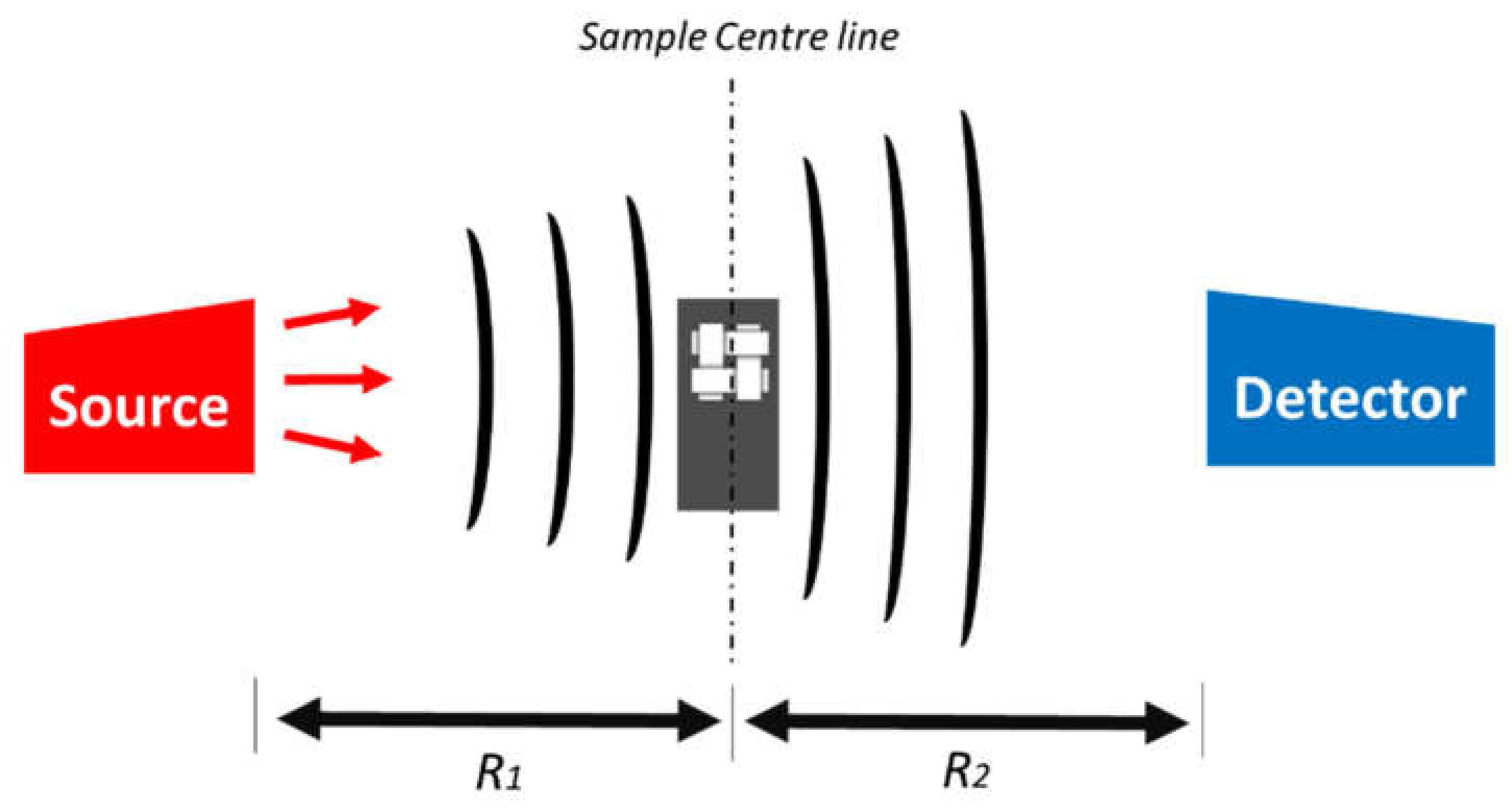
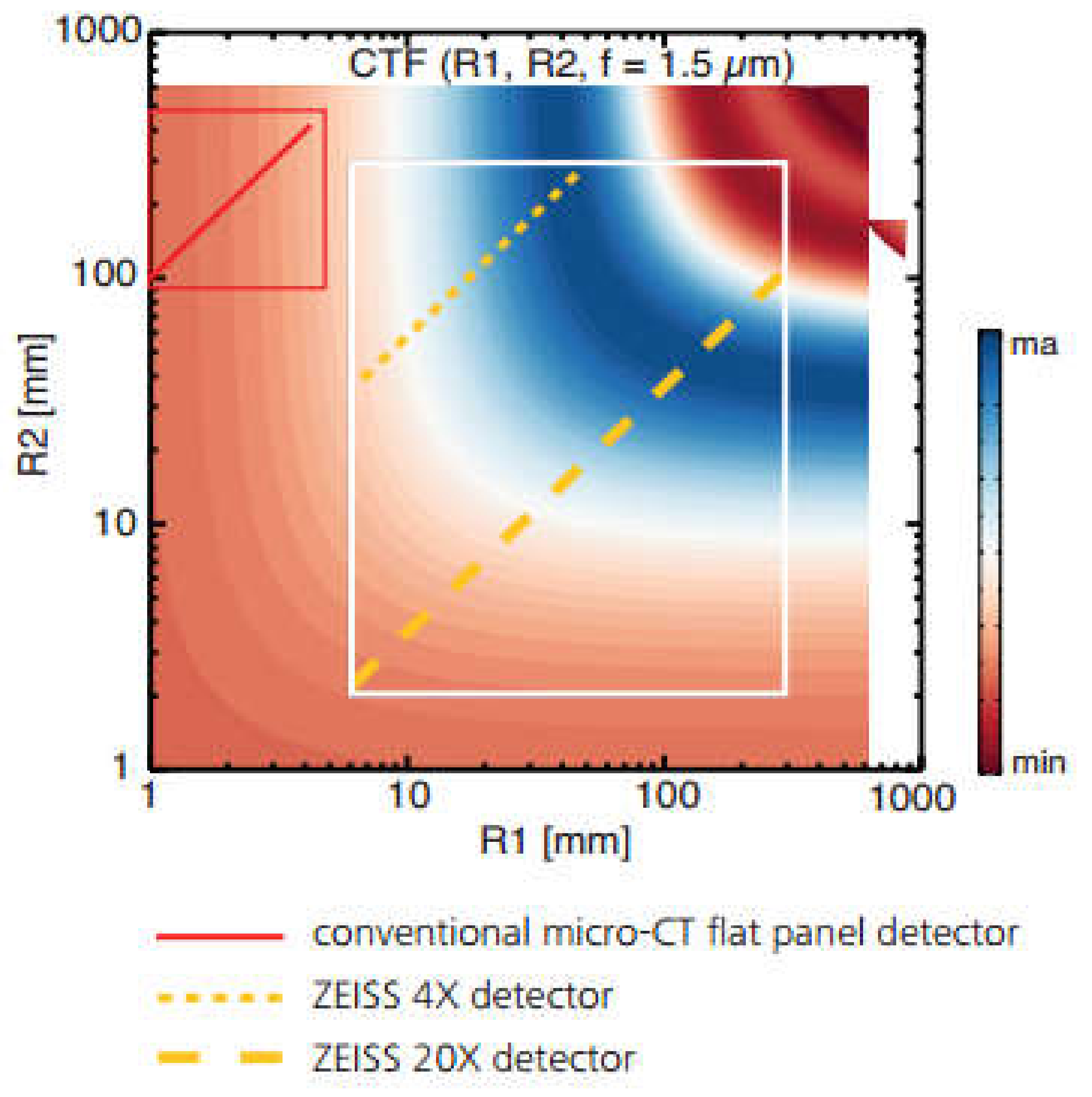
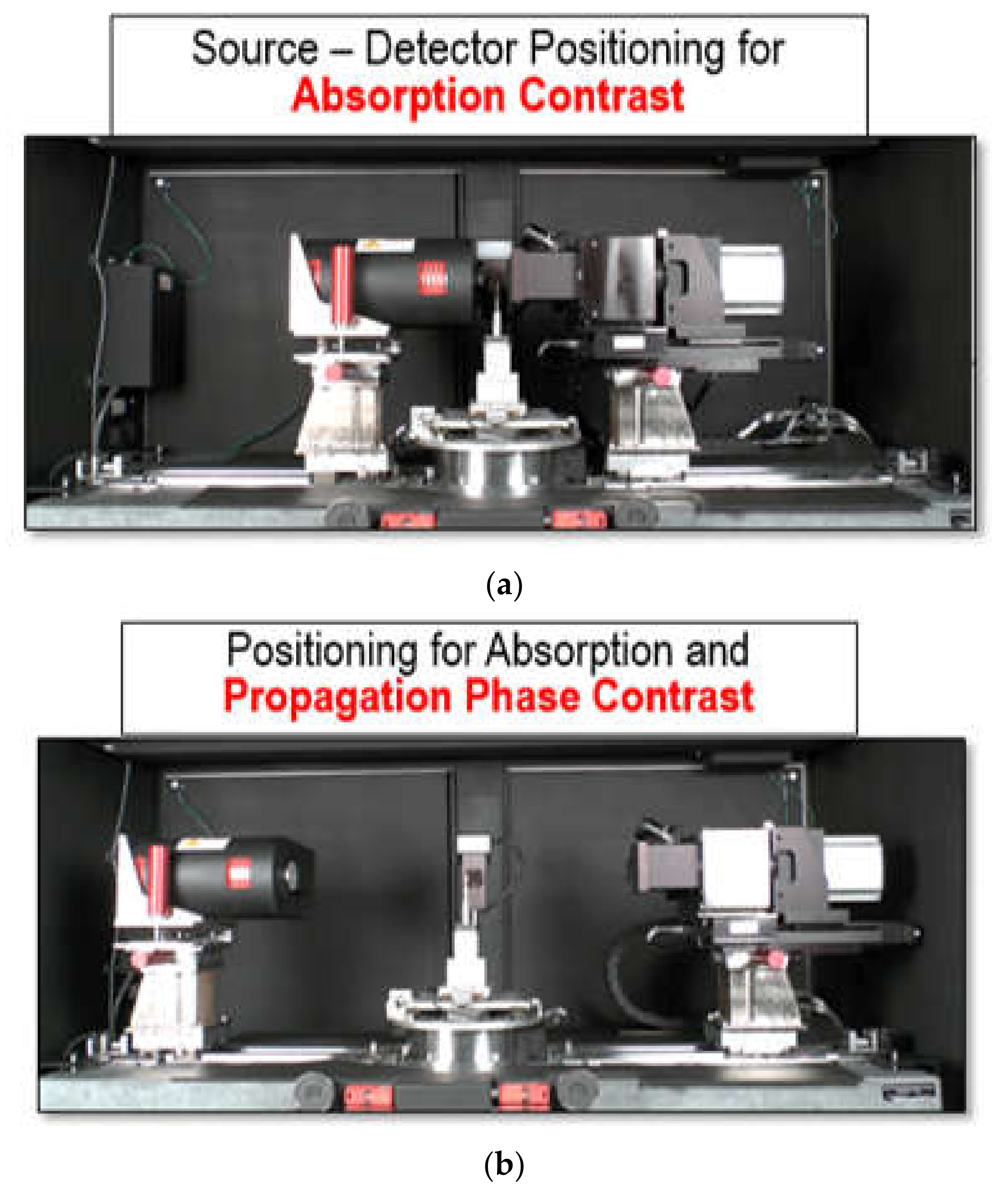
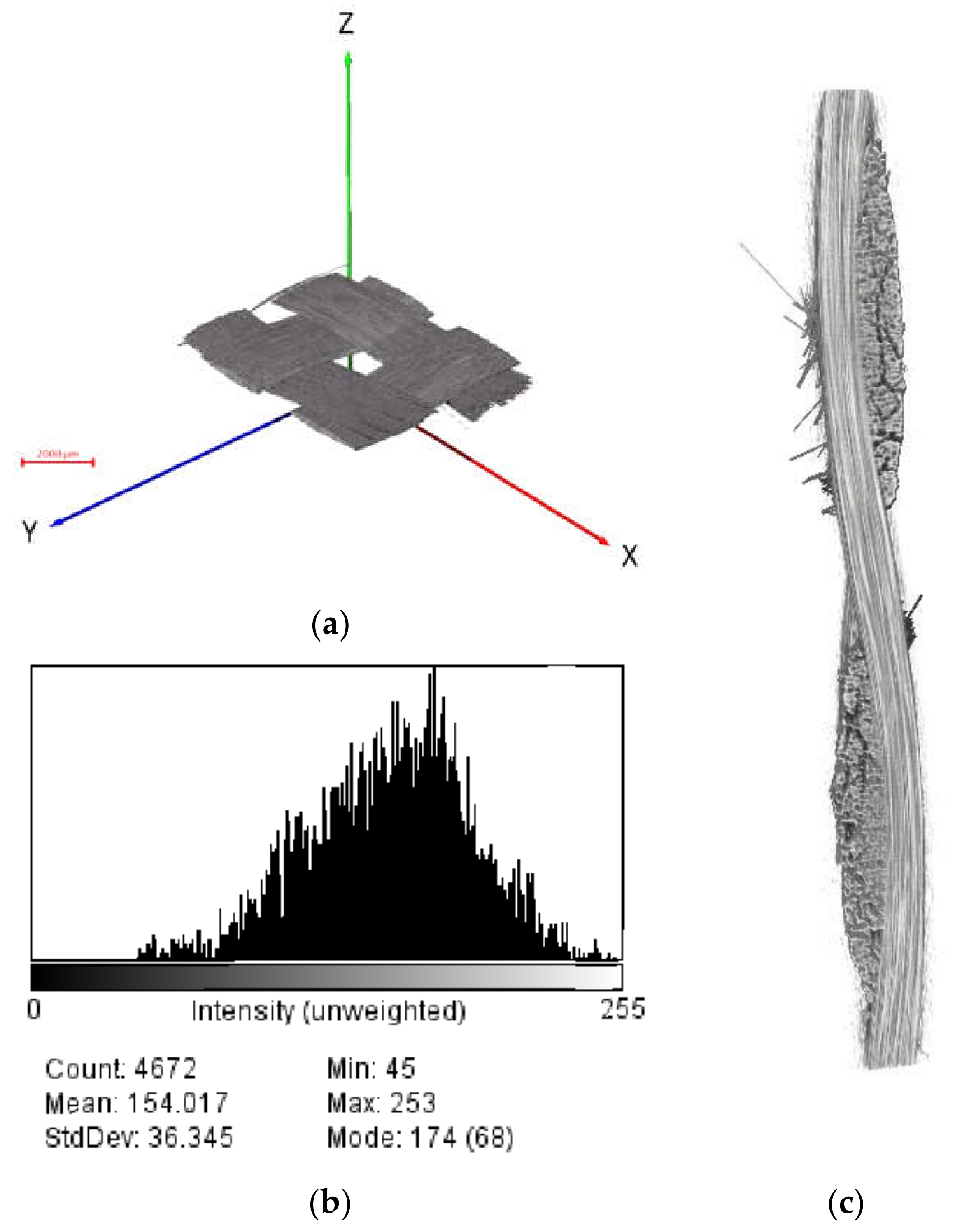
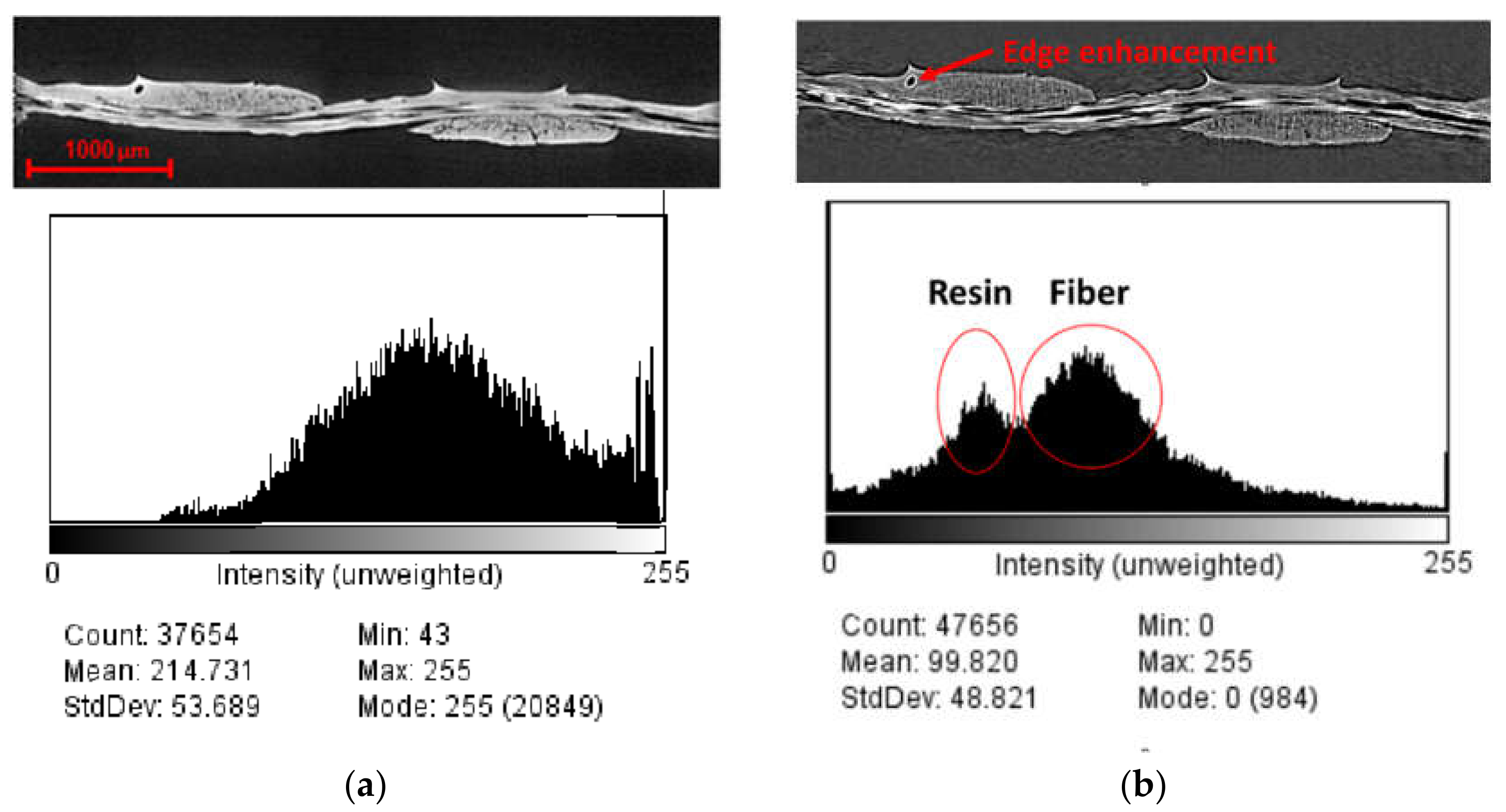
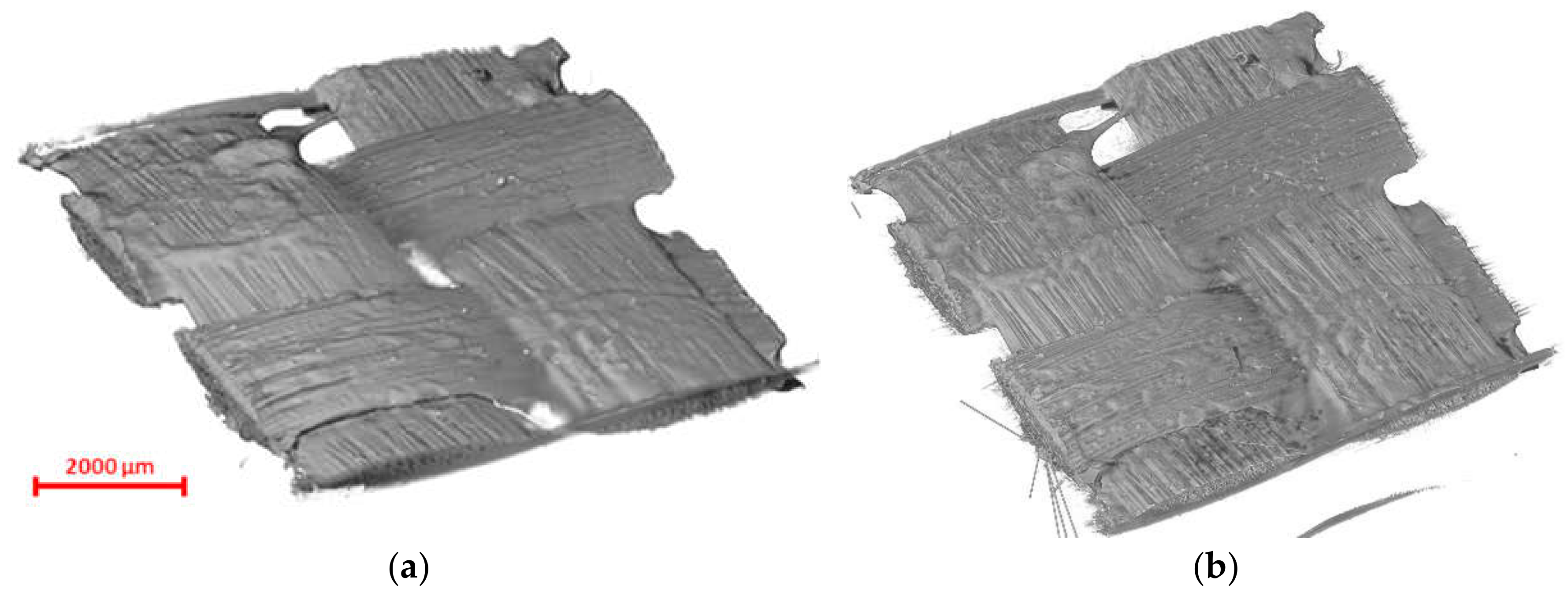
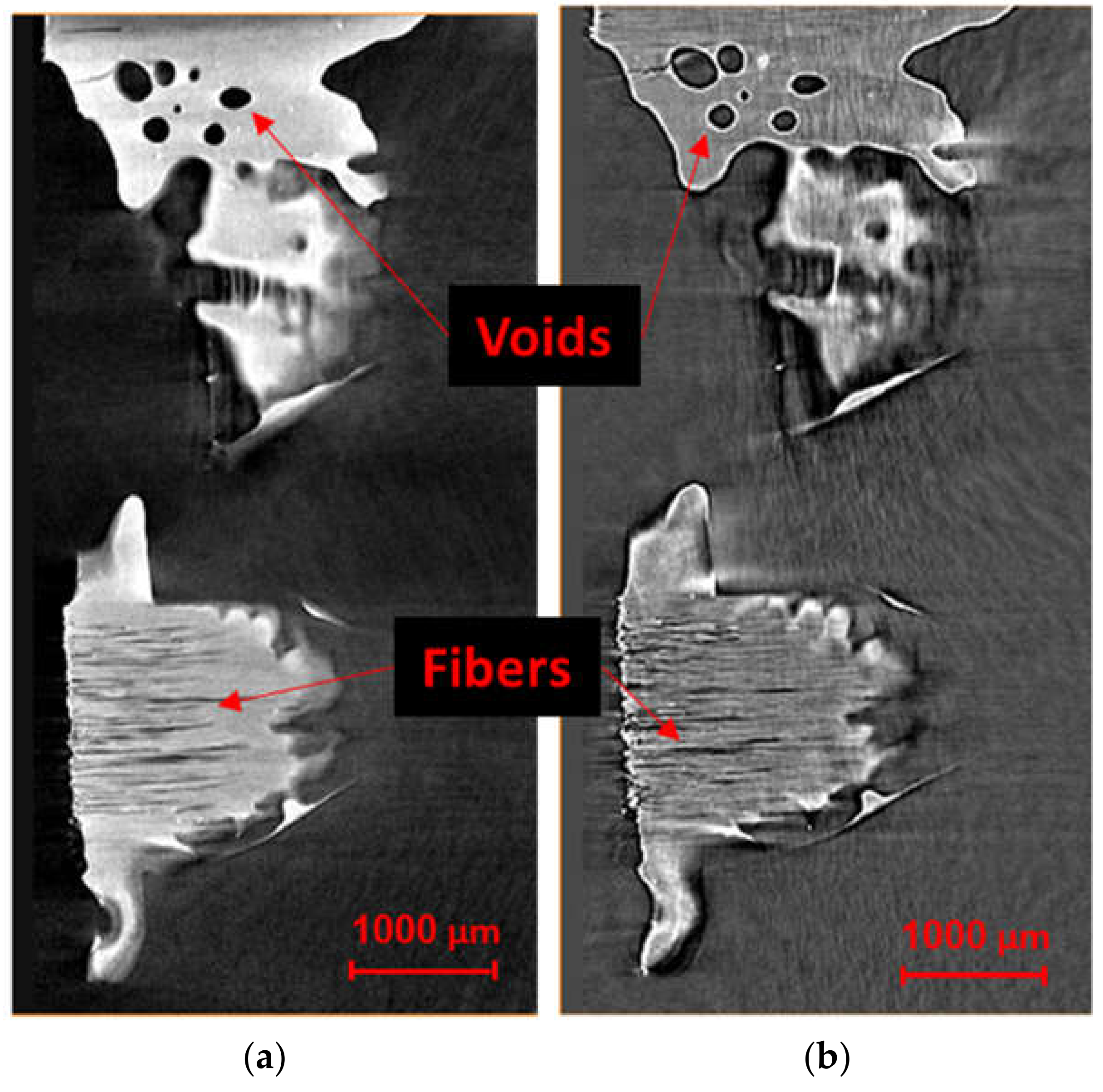
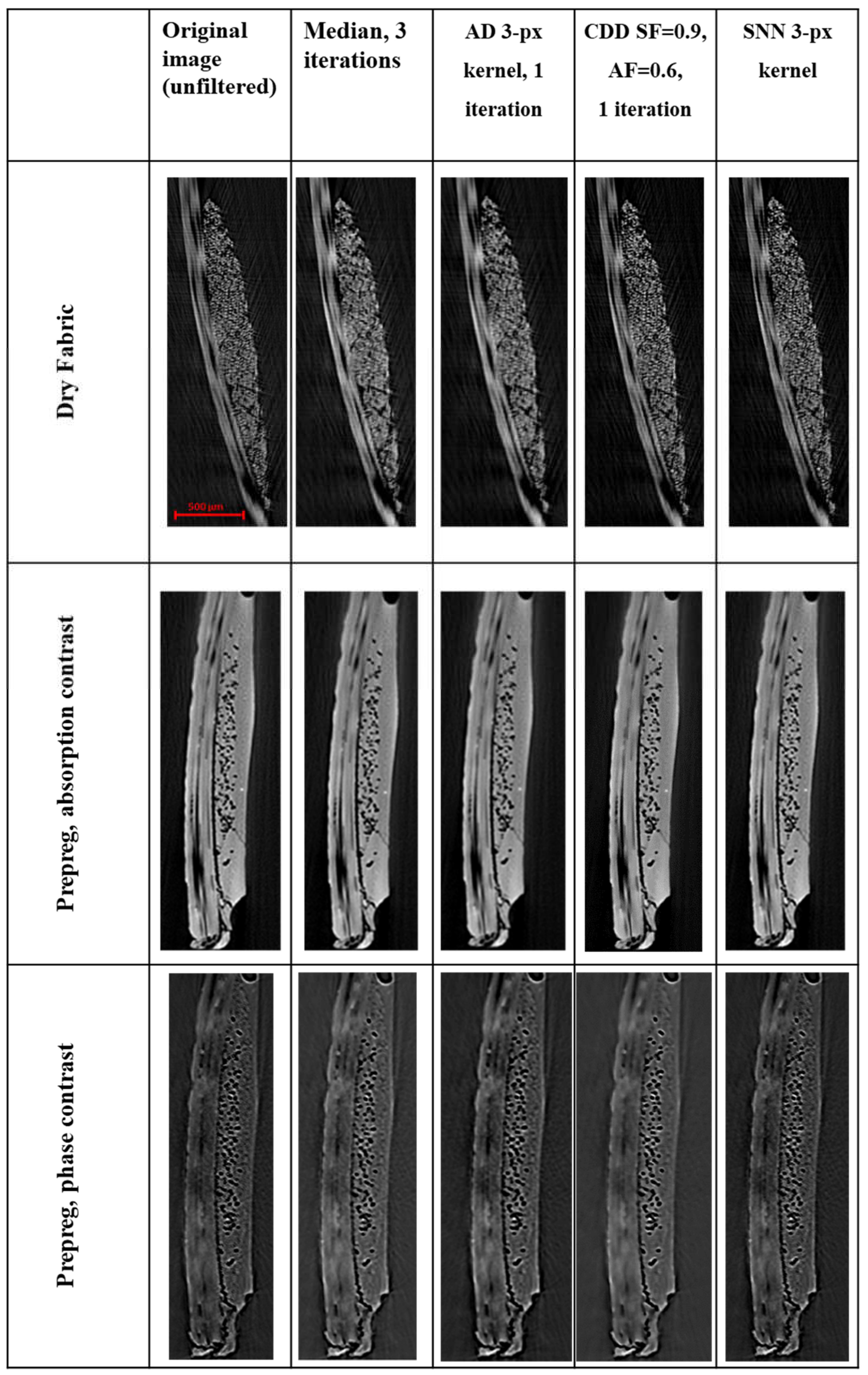


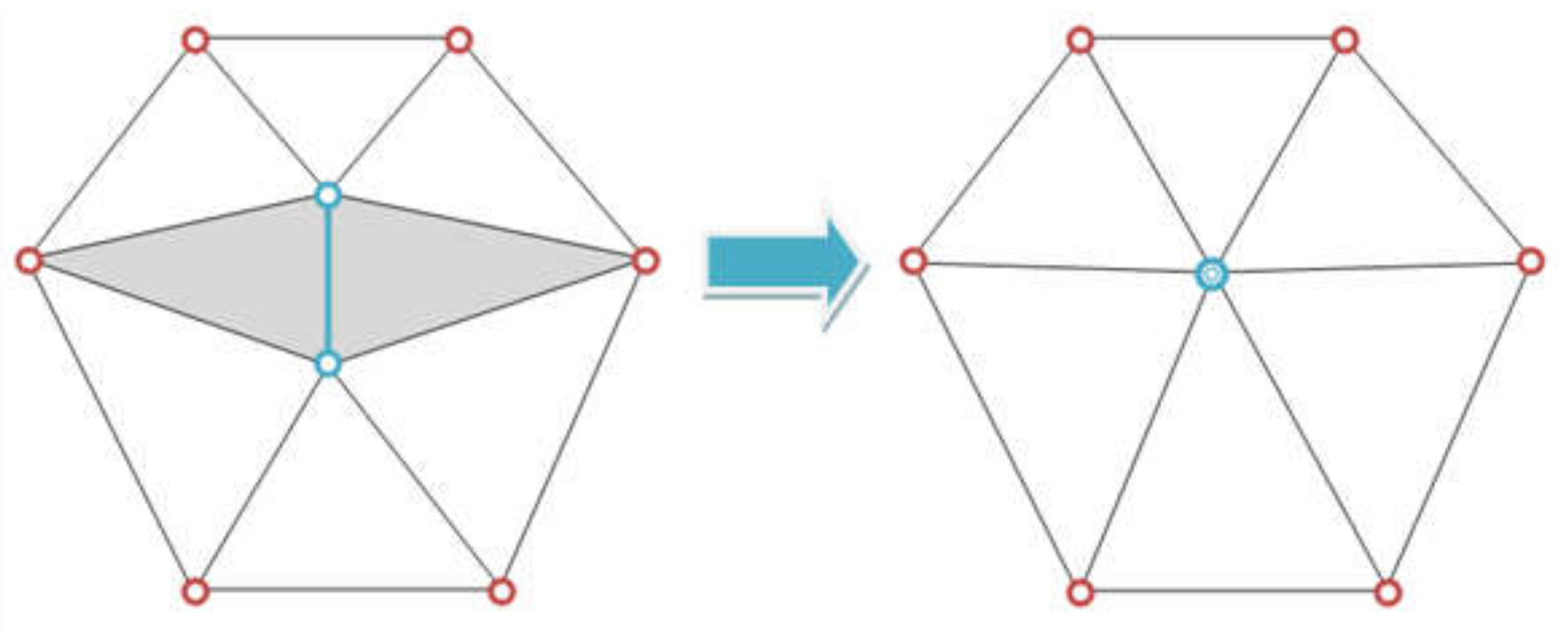

| Manufacturer | Cytec |
|---|---|
| Architecture | 3K–Plain Weave |
| Area density (g/m2) | 2722 |
| Sett (yarns/cm) | 3.5 |
| Filament diameter (µm) | 7.93 |
| Nominal thickness (mm) (dry fabric) | 0.295 |
| Nominal thickness (mm) (prepreg) | 0.33 |
| Resin type (prepreg) | CYCOM 970 Epoxy Resin |
| Case | Voxel Size (µm3) | Voltage (kV) | Power | Exposure Time (s) | Sample to Detector Distance (mm) | Sample to Source Distance (mm) |
|---|---|---|---|---|---|---|
| Dry Fabric | 2.88 | 40 | 10 | 20 | 8 | 47 |
| Prepreg (absorption contrast) | 2.47 | 40 | 15 | 5 | 12 | 32 |
| Prepreg (phase-contrast) | 2.47 | 40 | 20 | 210 | 300 | 500 |
© 2020 by the authors. Licensee MDPI, Basel, Switzerland. This article is an open access article distributed under the terms and conditions of the Creative Commons Attribution (CC BY) license (http://creativecommons.org/licenses/by/4.0/).
Share and Cite
Rashidi, A.; Olfatbakhsh, T.; Crawford, B.; Milani, A.S. A Review of Current Challenges and Case Study toward Optimizing Micro-Computed X-Ray Tomography of Carbon Fabric Composites. Materials 2020, 13, 3606. https://doi.org/10.3390/ma13163606
Rashidi A, Olfatbakhsh T, Crawford B, Milani AS. A Review of Current Challenges and Case Study toward Optimizing Micro-Computed X-Ray Tomography of Carbon Fabric Composites. Materials. 2020; 13(16):3606. https://doi.org/10.3390/ma13163606
Chicago/Turabian StyleRashidi, Armin, Tina Olfatbakhsh, Bryn Crawford, and Abbas S. Milani. 2020. "A Review of Current Challenges and Case Study toward Optimizing Micro-Computed X-Ray Tomography of Carbon Fabric Composites" Materials 13, no. 16: 3606. https://doi.org/10.3390/ma13163606





